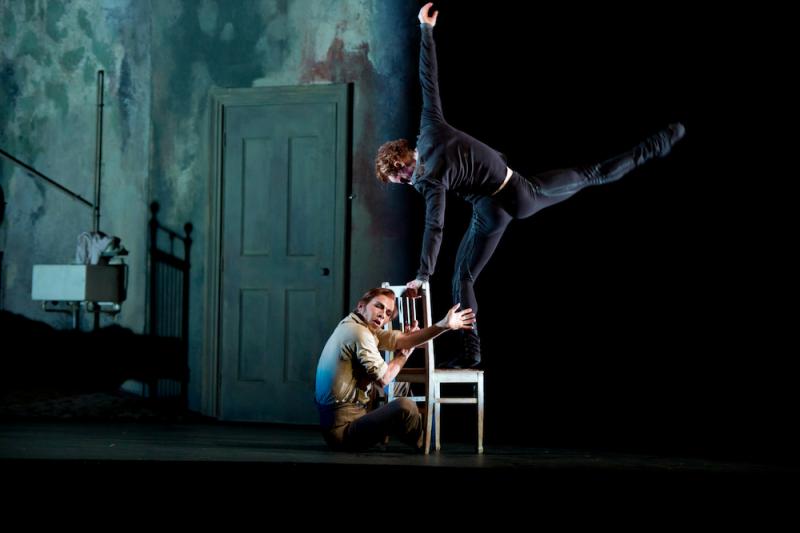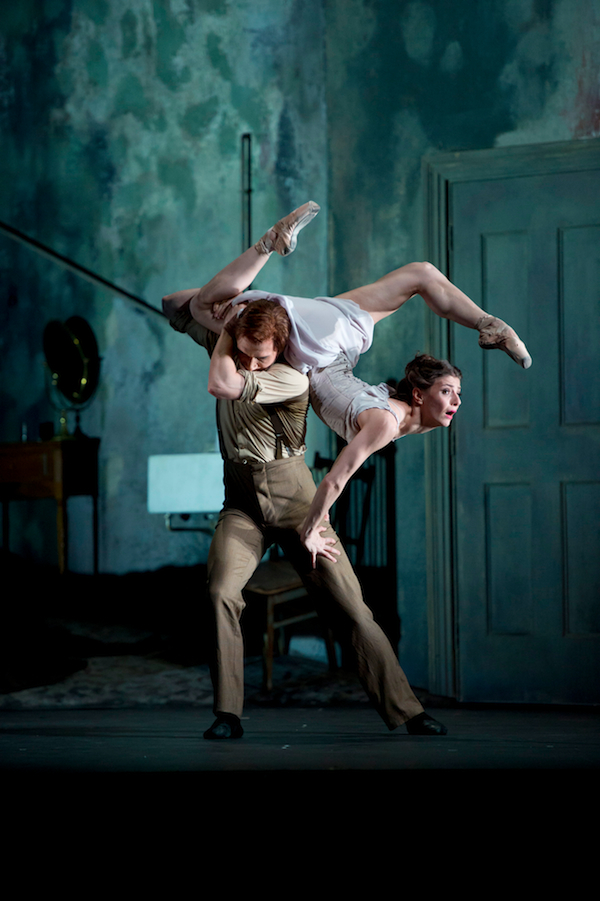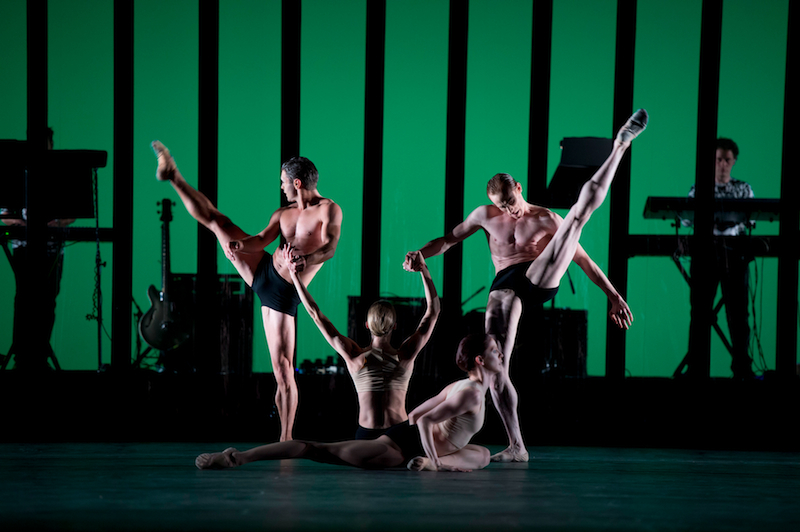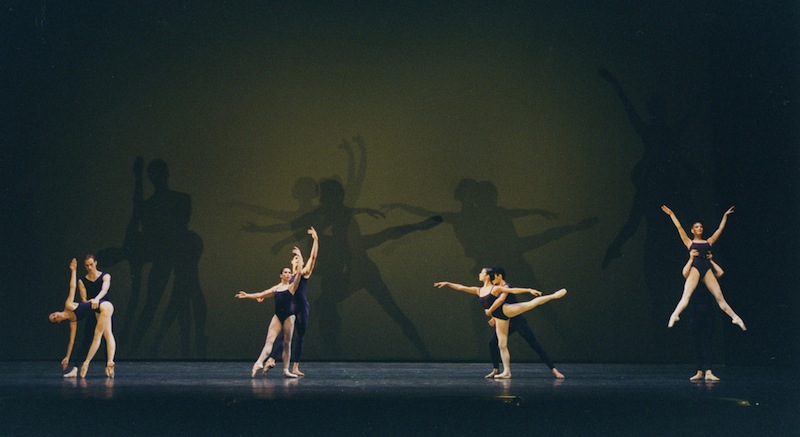Polyphonia/ Sweet Violets/ Carbon Life, Royal Ballet | reviews, news & interviews
Polyphonia/ Sweet Violets/ Carbon Life, Royal Ballet
Polyphonia/ Sweet Violets/ Carbon Life, Royal Ballet
Double disappointment for two world premieres, despite the hype

All year we've had to wait for a world premiere, and two come along at once. Last night was built to make some noise about the three most impressive young names in Royal Ballet choreography, and that will be where the PR story ends, but not where the flat disappointment ends. For while Christopher Wheeldon is shown at his magnificent best in an early piece, both Liam Scarlett and Wayne McGregor's new creations are nowhere near the best that either has shown.
They're opposites, but alike in why they fail. Scarlett’s Sweet Violets is an impenetrable jangle of narrative in the old style; McGregor’s Carbon Life an unyielding jangle of amoeba-like dance in the new. Each is richly decorated, Scarlett’s with fine theatrical sets for his psychodrama about Walter Sickert, a painter with a nasty turn of mind, and McGregor’s with a grid that goes up and down and an array of today’s popsters performing live on stage, Mark Ronson as composer and bass guitarist, Boy George, Hero Fisher, Alison Mosshart among the singers.
 Each sinks under the ponderous weight of its own image-making, but Scarlett's is a sadder flop, being a youngster who has made an outstanding start in semi-abstract ballets for the Royal Ballet. Possibly he was urged to do a narrative because of the fatal attraction of the Kenneth MacMillan Mayerling tradition, but this is far too clotted a scenario about the forces that possessed Sickert’s imagination, and his possible alter ego as Jack the Ripper (Johan Kobborg as Sickert pictured with Alina Cojocaru).
Each sinks under the ponderous weight of its own image-making, but Scarlett's is a sadder flop, being a youngster who has made an outstanding start in semi-abstract ballets for the Royal Ballet. Possibly he was urged to do a narrative because of the fatal attraction of the Kenneth MacMillan Mayerling tradition, but this is far too clotted a scenario about the forces that possessed Sickert’s imagination, and his possible alter ego as Jack the Ripper (Johan Kobborg as Sickert pictured with Alina Cojocaru).
It's not at all a bad idea, actually: the sexual control that a creator allows his model or performer to have over his fantasy is an exciting theme, and the slanted, suggestive staging by John Macfarlane turns the audience neatly into peeping Toms. For 15 good opening minutes you watch the murder, see the artist torn in imagination and longings between “day” and “night” existences, addicted to recreating the newspaper reports for his own relish, peopling the fantasies with the drab prostitutes and shadowy men of his circle.
But then facts and names rapidly get in the way of a good story. The Prime Minister enters the scene, along with an evil spirit with black eyes ("Jack") and a man called Eddy, Sickert’s model does a sexy striptease, another woman goes mad, and someone else murders someone else - all frenziedly complicated with gesture and mime, furtively lit, and with much scenery clattering importantly about.
Tamara Rojo relishes being 'partially nude' (warnings are given by the Opera House on this, for health and safety reasons)
Scarlett has a true and very promising choreographic talent, but a dance-maker isn’t a News of the World reporter. He should have been firmly ordered by his seniors to stop trying to do a Mayerling-meets-Jekyll and Hyde, junk half the characters, change the music and distil to the emotional essence. The great Johan Kobborg is criminally underused in the main role, turned into a bufferish old Don Quixote wandering about the over-populated stage, observing his predicament rather than being in it.
The rest is typecasting: Thiago Soares as yet another handsome villain, Steven McRae yet another supernatural, Alina Cojocaru emitting sparrow-like misery in her translucently lovely way, Tamara Rojo relishing being "partially nude" (warnings are given by the Opera House on this, for the health and safety of the more fragile members in the audience). Laura Morera’s madness is inexplicable unless you read all the programme notes later (she’s had a baby by Queen Victoria’s grandson - he’s Eddy, that’s why the Prime Minister came in...). All major artists in niggardly material.
Part of the problem is Scarlett’s choice of music - piano trios by Rachmaninov, a man for whom excess is normal garb, but frankly, in this turgid, fraught obscurity, the three musicians had the best deal.
 Above: Carbon Life, with Paul Kay, Melissa Hamilton, Olivia Cowley and Edward Watson
Above: Carbon Life, with Paul Kay, Melissa Hamilton, Olivia Cowley and Edward Watson
McGregor’s Carbon Life is equally verbose, but in an anonymising way. Despite being vibrantly staged with live rock band upstage, and Ronson, Boy George and Alison Mosshart prowling the line, the piece's choreography is infuriatingly bland, turning its individuals in black bodysuits into an identikit unisex crowd. Every leg is similarly free and easy, every body similarly flexible, men and women merge in their mutant uniform (the shark fins and pointy hats are the signs of Gareth Pugh’s involvement).
There are sudden but brief moments where humans replaced humanoids, such as an attractively spun duet for Sarah Lamb and Steven McRae. But generally it’s a fast, sexless aftershock to the powerful disturbance Michael Clark was creating with similar ingredients 25 years ago, and yet again I feel that McGregor’s choreography with the Royal Ballet looks ever more like a familiar house brand and ever less like a real inquiry (as he does show at his non-ballet company Random). This doesn't stop noisy love from the audience.
For true inquiry, true exhilaration, look no further than the programme’s opener, Wheeldon’s Polyphonia. Fierce, enigmatic, tender and provocative by turns, it is a spectacularly skilled and inspired exploration of balletic flexibility by eight dancers, in 10 clipped episodes that are indivisible from the spiky wit of György Ligeti’s piano pieces, deftly played by Robert Clark. The acrobatics become magnetic pieces of dance by being so finely figured, Zen meets Cubism, as intricately tooled lifts catch the billow of a crescendo.

Leanne Benjamin, tiny and threatening, creates angles that apparently defeat possibility, Beatriz Stix-Brunell shows a gorgeously unhurried air of mystery in a rare (for Wheeldon) solo, and Alexander Campbell’s musicality and Itziar Mendizabal’s boldness show how well Wheeldon encourages individuality, even within highly controlled patterns. But oy vey, the rest of the evening after it.
Share this article
Add comment
The future of Arts Journalism
You can stop theartsdesk.com closing!
We urgently need financing to survive. Our fundraising drive has thus far raised £49,000 but we need to reach £100,000 or we will be forced to close. Please contribute here: https://gofund.me/c3f6033d
And if you can forward this information to anyone who might assist, we’d be grateful.

Subscribe to theartsdesk.com
Thank you for continuing to read our work on theartsdesk.com. For unlimited access to every article in its entirety, including our archive of more than 15,000 pieces, we're asking for £5 per month or £40 per year. We feel it's a very good deal, and hope you do too.
To take a subscription now simply click here.
And if you're looking for that extra gift for a friend or family member, why not treat them to a theartsdesk.com gift subscription?
more Dance
 'We are bowled over!' Thank you for your messages of love and support
Much-appreciated words of commendation from readers and the cultural community
'We are bowled over!' Thank you for your messages of love and support
Much-appreciated words of commendation from readers and the cultural community
 R:Evolution, English National Ballet, Sadler's Wells review - a vibrant survey of ballet in four acts
ENB set the bar high with this mixed bill, but they meet its challenges thrillingly
R:Evolution, English National Ballet, Sadler's Wells review - a vibrant survey of ballet in four acts
ENB set the bar high with this mixed bill, but they meet its challenges thrillingly
 Like Water for Chocolate, Royal Ballet review - splendid dancing and sets, but there's too much plot
Christopher Wheeldon's version looks great but is too muddling to connect with fully
Like Water for Chocolate, Royal Ballet review - splendid dancing and sets, but there's too much plot
Christopher Wheeldon's version looks great but is too muddling to connect with fully
 iD-Reloaded, Cirque Éloize, Marlowe Theatre, Canterbury review - attitude, energy and invention
A riotous blend of urban dance music, hip hop and contemporary circus
iD-Reloaded, Cirque Éloize, Marlowe Theatre, Canterbury review - attitude, energy and invention
A riotous blend of urban dance music, hip hop and contemporary circus
 How to be a Dancer in 72,000 Easy Lessons, Teaċ Daṁsa review - a riveting account of a life in dance
Michael Keegan-Dolan's unique hybrid of physical theatre and comic monologue
How to be a Dancer in 72,000 Easy Lessons, Teaċ Daṁsa review - a riveting account of a life in dance
Michael Keegan-Dolan's unique hybrid of physical theatre and comic monologue
 A Single Man, Linbury Theatre review - an anatomy of melancholy, with breaks in the clouds
Ed Watson and Jonathan Goddard are extraordinary in Jonathan Watkins' dance theatre adaptation of Isherwood's novel
A Single Man, Linbury Theatre review - an anatomy of melancholy, with breaks in the clouds
Ed Watson and Jonathan Goddard are extraordinary in Jonathan Watkins' dance theatre adaptation of Isherwood's novel
 Peaky Blinders: The Redemption of Thomas Shelby, Rambert, Sadler's Wells review - exciting dancing, if you can see it
Six TV series reduced to 100 minutes' dance time doesn't quite compute
Peaky Blinders: The Redemption of Thomas Shelby, Rambert, Sadler's Wells review - exciting dancing, if you can see it
Six TV series reduced to 100 minutes' dance time doesn't quite compute
 Giselle, National Ballet of Japan review - return of a classic, refreshed and impeccably danced
First visit by Miyako Yoshida's company leaves you wanting more
Giselle, National Ballet of Japan review - return of a classic, refreshed and impeccably danced
First visit by Miyako Yoshida's company leaves you wanting more
 Quadrophenia, Sadler's Wells review - missed opportunity to give new stage life to a Who classic
The brilliant cast need a tighter score and a stronger narrative
Quadrophenia, Sadler's Wells review - missed opportunity to give new stage life to a Who classic
The brilliant cast need a tighter score and a stronger narrative
 The Midnight Bell, Sadler's Wells review - a first reprise for one of Matthew Bourne's most compelling shows to date
The after-hours lives of the sad and lonely are drawn with compassion, originality and skill
The Midnight Bell, Sadler's Wells review - a first reprise for one of Matthew Bourne's most compelling shows to date
The after-hours lives of the sad and lonely are drawn with compassion, originality and skill
 Ballet to Broadway: Wheeldon Works, Royal Ballet review - the impressive range and reach of Christopher Wheeldon's craft
The title says it: as dancemaker, as creative magnet, the man clearly works his socks off
Ballet to Broadway: Wheeldon Works, Royal Ballet review - the impressive range and reach of Christopher Wheeldon's craft
The title says it: as dancemaker, as creative magnet, the man clearly works his socks off
 The Forsythe Programme, English National Ballet review - brains, beauty and bravura
Once again the veteran choreographer and maverick William Forsythe raises ENB's game
The Forsythe Programme, English National Ballet review - brains, beauty and bravura
Once again the veteran choreographer and maverick William Forsythe raises ENB's game

Comments
Yet another review from
Whilst agreeing that
James, thank you for that
James, thank you for that correction, which I've made. From a distance, in that styling, the two men looked very similar.
A disgracefully sour review.
I guess it's because I've
I guess it's because I've played a certain amount of Rachmaninov for most of my life, and listened to more, that I appreciate his excess in some contexts and not in others. Perhaps you will allow that doesn't make me totally "ignorant of his talent". And perhaps 50 years of music-making and 30 years of watching dance might just qualify me for an opinion of some kind "on any cultural activity"? Your world does seem a little lonely, if I may say so. Ismene
I rarely comment as a point
Agreed. I would also just
PS please can someone from
I shared some of Ismene's